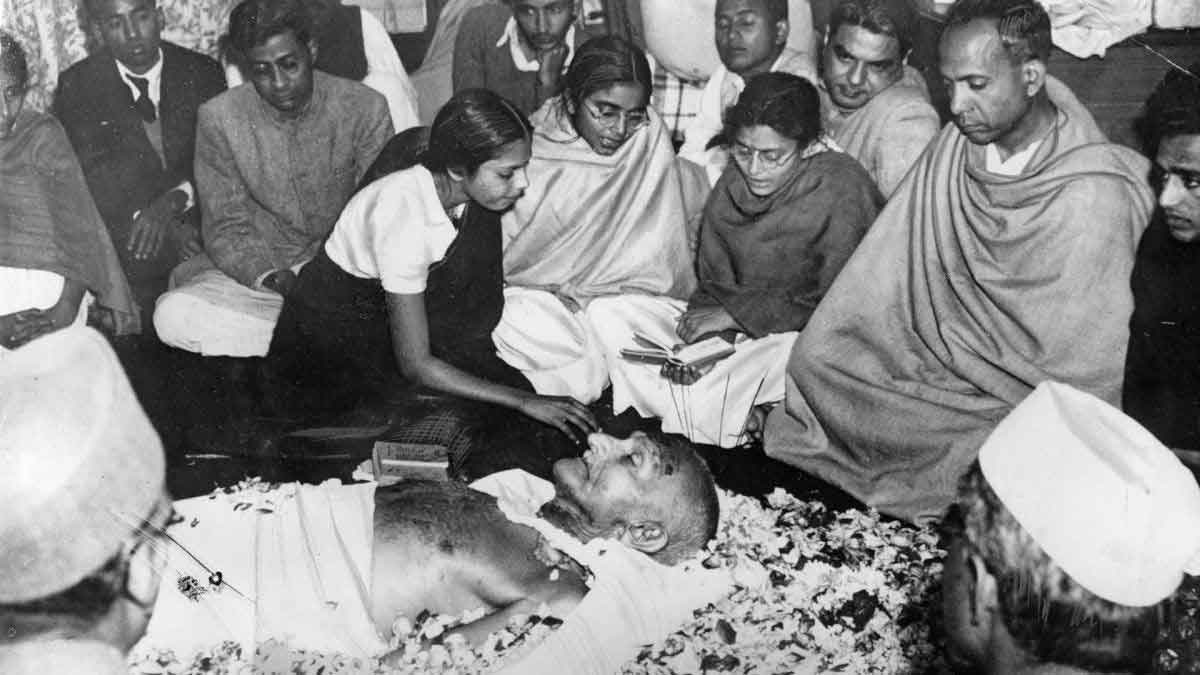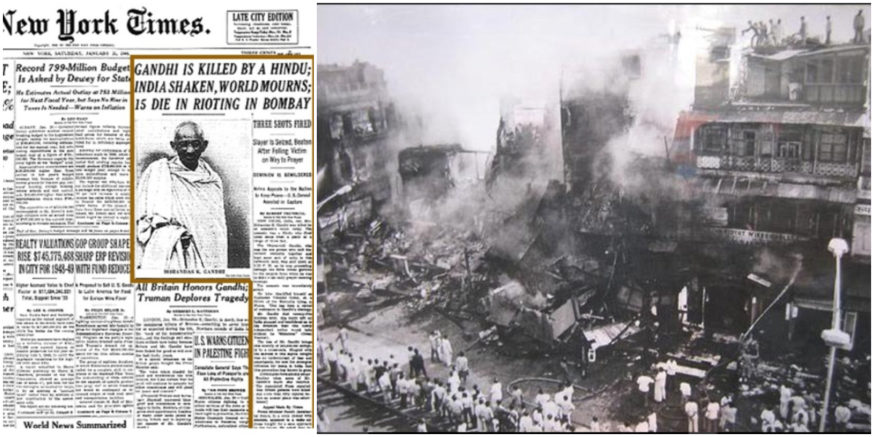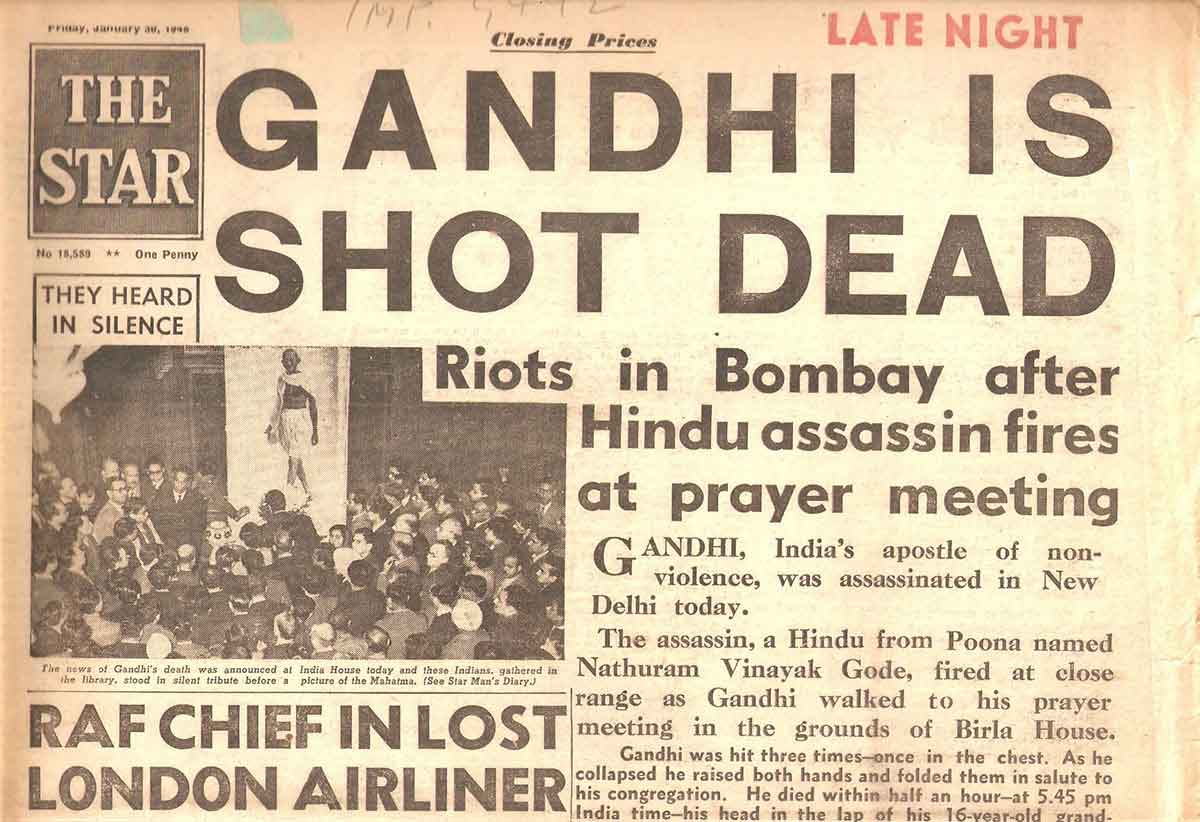Sanatan Articles
Satyaagrah
Written on
Satyaagrah
Written on
Satyaagrah
Written on
Satyaagrah
Written on
Satyaagrah
Written on
JOIN SATYAAGRAH SOCIAL MEDIA
The first large-scale massacre in Independent India accounts for one of the biggest coverups in modern history: It is about time we talk about the 1948 genocide of Maharashtrian Brahmins following MK Gandhi’s assassination

The aftermath of violence that spread after Mohandas Gandhi’s assassination is finally making gradual waves to the mainstream national discourse. However, the flames haven’t been distinguished and the pains have been preserved. The silencing of voices that followed one of the first large-scale massacres in Independent India accounts for one of the biggest coverups in modern history. It is need of the hour, that we talk about the crimes against Brahmins of Maharashtra that erupted after MK Gandhi’s assassination in 1948.
1948 Brahmin massacre in Maharashtra
M K Gandhi was assassinated by Nathuram Vinayak Godse on January 30, 1948, in Delhi. The news sent shock waves across the country. Nathuram Godse belonged to an orthodox Chittapavan Brahmin family living in Pune.
Resentment against the Brahmins had already been cultivated by this time, as a response to their hegemonical hundred-year-old rule under the Peshwa family. As soon as the family and caste details of Godse were made public, violence abruptly outpoured in major cities of Maharashtra. Starting with Pune, the wildfire spread across Brahmin localities in Pune with as many as 50 Brahmins identified and killed on 30th January 1948 itself.
The New York Times had already reported the news of ‘fifteen persons killed with more than fifty injured’ in communal riots that ‘swept’ the city of Bombay on the next day. The spurge of violence reached quickly to other cities in southern and western Maharashtra, while Nagpur in Vidarbha emerged as a hotbed of violence too.
 |
Persecution of Brahmins after M K Gandhi’s assassination
Advocate P.L.Inamdar as quoted in Vikram Sampath’s Savarkar Vol. II had noted the primary reason behind the persecution of Brahmins; which was Nathuram Godse, who killed Gandhi belonged to the Chittapavan Brahmin community in Maharashtra. Writing about the ‘manhunt’ that followed the assassination, Inamdar said, “Some of my close relatives living in southern districts of Maharashtra were being made victims of this manhunt only because they were Maharashtrian Brahmins. They escaped being lynched only by the sheer chance of not being found in their houses at the time of the raids.”
Talking about the violence that erupted in Nagpur, which was part of the Central Provinces then, Dwarka Prasad Mishra, a senior Congress leader himself, wrote unapologetically in his memoirs about the mayhem that followed. He wrote, “Those who indulged in unlawful activities also included a large number of Congressmen belonging to non-brahmin communities. In fact, in Nagpur and Berar the troublemakers were mostly Congressmen, some being even office bearers of various Congress Committees.”
While the media of the time had turned a blind eye to the events that were unfolding, state pressure to discourage any recording of the events also accounted for the dearth of resources available today. It was only after British Journalist Maureen Patterson who was researching the aftermath of Gandhi’s death in India, wrote decisively about the violence against the Brahmins of Maharashtra in 1948 that people started talking about it.
Patterson has recorded several instances of targeting, riots, and disturbances directed to the cleansing of Brahmins from Maharashtra’s rural interiors. She recorded that magnified violence that also spread in the Deccan cities like Satara, Kolhapur, and Belgaum. A conservative estimate of total damage around Rs. 6 to 10 crores by the violent activities was calculated by the scholar based on unofficial numbers and anecdotal publications.
While the violence started with the targeting of people surnamed ‘Godse’, the casteist ire quickly spread categorically across all subcastes beyond the Chittapavans (Konkanasthas) to Deshastha and Karhade Brahmin communities in Maharashtra as well. As reported, veteran journalist Gajanan Tryambak Madkholkar lost his home and premises of his newspaper publishing house in Nagpur to the violence. In Kolhapur, renowned filmmaker of the times, Bhaji Pendharkar – a Karhade Brahmin suffered a huge loss with damage to his studio. Property damages, burning of homes, mills, factories owned by brahmins were rampant in Kolhapur, Sangli, and other districts.
 |
Anti-Brahmin resentment in Maharashtra
While analyzing the aftermath of MK Gandhi’s murder, there appears to be a combination of multiple narratives underplay which culminated into the anti-Brahmin violence. At the outset, it was the Gandhian Ahimsa-vaadis themselves who retorted to mass violence as a tool to avenge his murder. As mentioned earlier, Dwarka Prasad Mishra had confessed as a member of Congress himself, about the role of ‘Congressmen’ in leading the violence against the Brahmin community. They were later joined by leaders from the non-Brahmin communities who had a personal axe to grind against the ‘influential’ Brahmins who made their fortunes in the 18th and the 19th centuries.
A community that has historically consolidated not more than 4-5% of Maharashtra’s population, rose to considerable influence and power when the Shrivardhankar Bhat family ruled the Maratha Empire as Peshwas or Prime Ministers. With the rise of the Peshwas, the Brahmin community wielded a hegemonical control over many walks of life as mercenaries, money lenders, businessmen, and over other service-related activities related to the intellect.
Over time, this outpoured resentment against the community which was also fueled by the staunch discriminatory practices against the lower castes upheld during the times. So much so, when an indecisive battle at Bheema-Koregoan was led by the Mahar battalion in the English army against the Maratha Empire, it was touted as the victory of ‘lower castes’ over the ‘Brahmin’ Peshwas. The archaic resentment against the Brahmins joined by violence perpetrated by the angry Congress led to the apocalyptic mayhem after January 30, 1948.
The unheard voices which suffered the violence have chosen to stay silent and move on. It all started with a group of Hindu-nationalist men from the Brahmin community, killing Gandhi over his policies regarding the partition. Neither Godse’s ideology nor his caste identity had anything to do with his justification of the murder. Yet, the consequences of this mindless act were suffered by Hindu nationalists and the Brahmins unsparingly. The modern state of Maharashtra continues to disengage with the stories of the pillage of Marathi Brahmins that took place during the reigns of the Bombay state presidency. The Congress leaders which took part in the genocidal violence continue to keep their strongholds in parts of the newly formed state, with their heirs holding ministerial ranks in the state cabinet. The local politics thence continued to propel the narrative of a ‘progressive Maharashtra’ lead by the ideals of ‘Shahu-Phule-Ambedkar’ while suitably leaving no space for leaders from the Brahmin community. The aftermath of the violence also explains the plight of the Brahmins from the villages and their rapid migration into the cities, as many families succumbed to threats during the 1960s. Even today, the Maharashtrian Brahmins as a minority community does not hold much say in the politics of the state dominated by the Marathas and the Kunbis.
Moreover, it was ironic that the upholders of the ‘absolute non-violence’ ideology – followers of Gandhi himself, presided over one of the first hate crimes that happened in Independent India. The episode of violence against Brahmins in Maharashtra was the first blot on the legacy of Mohandas Gandhi as an upholder of peace and non-violence. The state headed by the Congress party is equally complicit in erasing the traces of truth from the mainstream. History, however, has a window of opportunity to heal the silenced wounds. Sheer acknowledgment of the brutal violence, lead by hate against the Maharashtrian Brahmins as genocide would go a long way.
 |
References:
opindia.com - Suyash Sherekar
 Support Us
Support Us
Satyagraha was born from the heart of our land, with an undying aim to unveil the true essence of Bharat. It seeks to illuminate the hidden tales of our valiant freedom fighters and the rich chronicles that haven't yet sung their complete melody in the mainstream.
While platforms like NDTV and 'The Wire' effortlessly garner funds under the banner of safeguarding democracy, we at Satyagraha walk a different path. Our strength and resonance come from you. In this journey to weave a stronger Bharat, every little contribution amplifies our voice. Let's come together, contribute as you can, and champion the true spirit of our nation.
 |  |  |
| ICICI Bank of Satyaagrah | Razorpay Bank of Satyaagrah | PayPal Bank of Satyaagrah - For International Payments |
If all above doesn't work, then try the LINK below:
Please share the article on other platforms
DISCLAIMER: The author is solely responsible for the views expressed in this article. The author carries the responsibility for citing and/or licensing of images utilized within the text. The website also frequently uses non-commercial images for representational purposes only in line with the article. We are not responsible for the authenticity of such images. If some images have a copyright issue, we request the person/entity to contact us at This email address is being protected from spambots. You need JavaScript enabled to view it. and we will take the necessary actions to resolve the issue.
Related Articles
- Harmonizing Nathuram Godse: Why India should move beyond denouncing him, a man who altered the course of not only the politics of the country but the very history of the Hindu Civilisation and, by extension, the world at large
- The untold story of Maharashtrian Brahmin genocide committed by Congress after Gandhi’s assassination in 1948
- Father of the Nation! Absolutely not. Mohandas Karamchand Gandhi was not the father of the nation either officially or otherwise
- Netaji, an Impossible man can never be boxed into an ideological corner: Not just the most enigmatic figure in world history but his life is also a tough lesson in how to think about history
- Ghost from the past: Unseen picture of Nehru voting in favour of partition of India goes viral
- When Secular Nehru Opposed Restoration Of Somnath Temple - The Somnath Temple treachery
- If only India’s partition chilling wound was not enough, Gandhi did his last protest again only to blackmail India into giving 55 crores to Pakistan, dragged Hindu, Sikh refugees seeking shelter in mosques to die in cold: And we call him Mahatma, not for
- The untold exodus of 1.5 lakh Punjabi Hindus to Delhi’s Piragarhi camp; forced upon by Sikh radical Khalistani terrorists led by Bhindranwale
- Nehru's Himalayan Blunders which costed India dearly - Integration of Princely States
- Moplah Genocide of the Malabar Hindus, 1921: Thousands of Hindus slaughtered
- Speech of Sardar Patel at Calcutta Maidan in 1948 busts the myth of ‘Muslims chose India’ and is relevant even today
- Godse's speech and analysis of fanaticism of Gandhi: Hindus should never be angry against Muslims
- 'Muh me ram bagal me chhuri' - Gandhi’s politics is hollow and noisy, full of treachery and deceit’: Read what Dr. Ambedkar said about the ‘Mahatma’
- During ‘Kheti Bachao Yatra’ in Kurukshetra Shehjada Gandhi claimed of throwing China out from Indian Territory ‘in 15 minutes’: From Nehru’s Himalayan blunder to UPA’s silence as China took over Indian land in Ladakh
- Anuj Dhar claims that Subhas Chandra Bose was suspected of being ‘poisoned’ after ouster from the post of Congress president





















